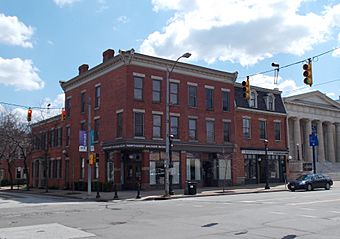Chandlery Corner facts for kids
Quick facts for kids |
|
|
Chandlery Corner
|
|

Chandlery Corner, April 2013
|
|
| Location | 1 and 3 E. Fourth St., and 401-403, and 405 State St., Erie, Pennsylvania |
|---|---|
| Area | 0.2 acres (0.081 ha) |
| Built | 1832, 1846, 1851 |
| Architectural style | Greek Revival, Federal |
| NRHP reference No. | 87000030 |
| Added to NRHP | February 5, 1987 |
Chandlery Corner is a special place in Erie, Pennsylvania. It is made up of three old buildings. These buildings are the Peter Rockwell House, the Frederick Schneider House, and the Schneider/Kessler Chandlery. They help us understand what the city looked like a long time ago!
Contents
What is Chandlery Corner?
Chandlery Corner is a group of three historic buildings in Erie, Pennsylvania. These buildings are important because they show how businesses worked in the 1800s. They give us a peek into the past of Erie's business area.
The Old Buildings of Chandlery Corner
One of the buildings is the Peter Rockwell House. It was built in 1832. This house was first a brick townhouse. It was built in a style called Federal style. This style was popular in the early days of the United States. Later, around 1865, it was changed to be a business building. It also got a special roof called a mansard roof.
Next is the Frederick Schneider House. It was built in 1846. This building is a two-story brick house. It was built in the Greek Revival style. This style often uses ideas from ancient Greek buildings, like columns.
The third building is the Schneider/Kessler Chandlery. It was built in 1851. This was a three-story brick building used for business.
Why is it called Chandlery Corner?
The name "Chandlery Corner" comes from its history. It was the place where Erie's first soap and candle maker had a factory and a store. A "chandlery" is a place where candles and soap are made or sold.
A Historic Landmark
Because of their importance to Erie's history, these buildings were added to the National Register of Historic Places in 1987. This means they are recognized as important historical sites that should be protected.



